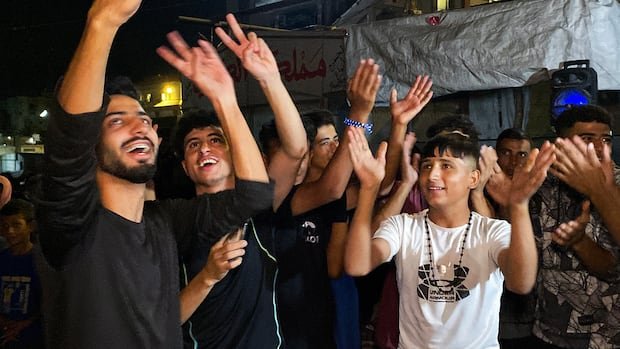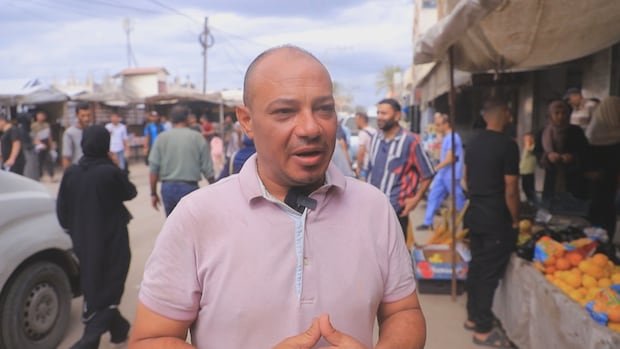The sense of relief sweeping across the Middle East and beyond over the news that a ceasefire in Gaza is finally within sight is palpable.
But negotiators have repeatedly stressed that the deal, reached in the early hours of the morning in Sharm el-Sheikh, Egypt, is just the first phase of a broader agreement still to be negotiated on permanently ending the war.
Even that first phase is fraught with peril. Either Israel or Hamas backsliding on perceived commitments would carry with it the potential to collapse the ceasefire.
For Palestinians in Gaza who have endured unprecedented hardship and bloodshed, and for desperate Israeli families whose loved ones have endured two years of captivity, that means anxiety is just as palpable as relief.
“My feelings are all over the place, you can’t imagine,” 27-year-old Mahmoud Abdallah told CBC News in an interview in Deir al-Balah, Gaza. “We’re scared to have hope like before and it fails. And the sad part is that there are many loved ones we miss in these moments.”
Israeli Yehuda Cohen, whose 21-year-old son Nimrod was taken captive by Hamas on Oct. 7, 2023, told the BBC’s Today program that his family still feels like it’s “in a state of limbo.”
“Out of hell,” he said, “but still not in the promised land…. Now, we know we’re going to hug our boy again, but the still open question is when and where.”
The initial phase of the agreement is predicated on all living Israeli hostages being released within 72 hours of the start of a ceasefire. Release of the bodies of another 28 may take more time.
Two-hundred and fifty Palestinian prisoners held in Israeli jails would also be released, along with 1,700 Gazans held by Israel during the war.
It’s also expected that desperately needed aid would then be allowed to start flowing into Gaza again.
Key details unclear
U.S. President Donald Trump has claimed the agreement, drawn from his original 20-point plan, has the potential to bring what he called “eternal peace.”
But the plan is one of broad strokes, with many key details yet to be filled in on the most intractable of issues.
That includes the extent to which Israeli troops will withdraw from Gaza and when. Hamas has insisted on full withdrawal and sought guarantees from the United States that it won’t allow Israel to restart the war once the hostages have been released.
It’s also unclear if Hamas has agreed to disarm, as per Israel’s demand, and if so, how the decommissioning process would work.
Future governance plans for Gaza are also unclear.
Israel has said the future governorship of Gaza can include neither the militant group Hamas nor the Palestinian Authority, which has nominal control in some parts of the occupied West Bank.
The Trump plan calls for a “Board of Peace” to be headed by himself with help from former British prime minister Tony Blair, a man held in contempt by many Palestinians.
There is also mention of an international security force of some kind, but it’s unclear which countries would participate.
Hear from three Palestinians in Deir al-Balah early Thursday after Israel and Hamas agreed to the first phase of a peace plan from U.S. President Donald Trump.
The wording of the original Trump plan also punts the issue of Palestinian statehood — a key demand for the Palestinians and the Arab countries that have brought pressure to bear on Hamas to accept the initial deal — far into the future.
It suggests that when Gaza’s redevelopment has advanced and reform of the Palestinian Authority has been undertaken, “the conditions may be in place for a credible pathway to Palestinian statehood, which is recognized as the aspiration of the Palestinian people.”
Ceasefire ‘positive, but it’s not enough’
One of the major criticisms of the failed Oslo peace process of the 1990s — which mainly involved Israeli prime minister Yitzhak Rabin and Palestinian leader Yasser Arafat — was that it deferred decisions on the deepest points of contention, the so-called final status issues. These included the right of displaced Palestinian refugees to return to their former homes, Israeli settlements in illegally occupied territory and the status of Jerusalem.
More than 30 years on, those issues remain as intractable as ever, and their resolution will inevitably be linked to the future of Gaza.
Key to resolving them will be sustained interest and — and, if needed, pressure — from the international community, with particular attention from the U.S. and key Middle Eastern nations.
In an interview with CBC News last week commenting on the overall Trump plan, longtime Palestinian politician Mustafa Barghouti said the agreement is not a good one for his people in the long term.
But he also said he couldn’t counsel against accepting it, given its potential to end immediate suffering in Gaza.
“This plan, the most important thing about it, [is] that it negates completely the idea of ethnic cleansing of Palestinians [in Gaza]” he said.
“That’s all positive, but it’s not enough. The other points in this agreement have to be negotiated.”
And if history is anything to go by, the longer that takes, the greater the potential for parties to run out the clock until talks are declared a failure.


